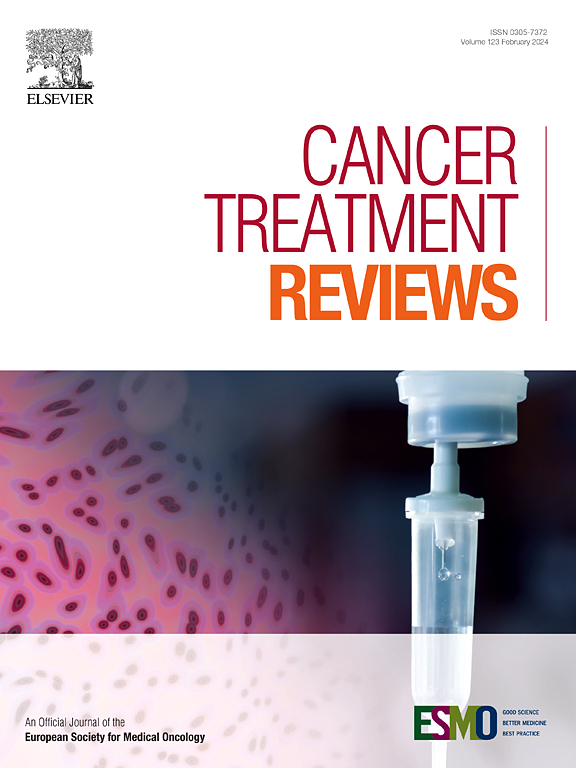Dealing with KRAS G12C inhibition in non-small cell lung cancer (NSCLC) – biology, clinical results and future directions
IF 9.6
1区 医学
Q1 ONCOLOGY
引用次数: 0
Abstract
KRAS G12C mutation occurs in ∼ 14 % of non-small cell lung cancer (NSCLC) patients and has been historically deemed undruggable, with immune-checkpoint inhibitors (ICIs) and platinum-based chemotherapy (PBC) representing the standard-of-care in the advanced setting. First-in-class, covalent KRAS G12C OFF-inhibitors sotorasib and adagrasib have revolutionized the therapeutic landscape and recently entered clinical practice. However, limited efficacy alongside toxicity profiles strengthen the need to design novel molecules and to optimize therapeutic strategies to address and overcome intrinsic and acquired resistance mechanisms. Moreover, KRAS G12C frequently co-occurs with STK11/KEAP1 mutations, that represent a negative prognostic factor, being associated with increased metastatic potential and reduced overall survival and poorer outcomes with ICIs. Furthermore, the high incidence of brain metastases is common in KRAS G12C-mutant NSCLC, and the efficacy of standard therapies and KRAS G12C inhibitors in treating or preventing central nervous system involvement is still suboptimal.
In this context, novel inhibitors, such as broad-spectrum inhibitors targeting the active GTP-bound ON-state, pan-RAS ON inhibitors and allele-selective tricomplex inhibitors, have showed promising early clinical activity although their clinical utility needs to be further elucidated. In addition, targeting upstream, downstream and parallel signaling pathways through combination strategies might enhance the activity of KRAS G12C inhibitors and eventually improve clinical outcomes in this subset of NSCLC patients. Several combinations are currently under clinical investigation and promising approaches include combinations of KRAS G12C inhibitors with ICIs, SOS1, SHP2 inhibitors and PBC. Notwithstanding the potential improved efficacy of combination strategies, tolerability remains a critical challenge that must be carefully assessed and managed.
KRAS G12C在非小细胞肺癌(NSCLC)中的抑制作用——生物学、临床结果和未来发展方向
KRAS G12C突变发生在约14%的非小细胞肺癌(NSCLC)患者中,历史上一直被认为是不可药的,免疫检查点抑制剂(ICIs)和铂基化疗(PBC)代表了晚期患者的标准治疗。一流的共价KRAS G12C off抑制剂sotorasib和adagrasib已经彻底改变了治疗领域,最近进入临床实践。然而,有限的疗效和毒性特征加强了设计新分子和优化治疗策略以解决和克服内在和获得性耐药机制的需要。此外,KRAS G12C经常与STK11/KEAP1突变共同发生,这是一个负面的预后因素,与转移潜力增加、总生存率降低和ICIs预后较差相关。此外,KRAS G12C突变型NSCLC的脑转移发生率较高,标准疗法和KRAS G12C抑制剂在治疗或预防中枢神经系统受损伤方面的疗效仍不理想。在这种背景下,新的抑制剂,如针对活性gtp结合ON状态的广谱抑制剂、泛ras ON抑制剂和等位基因选择性三复合物抑制剂,已经显示出有希望的早期临床活性,尽管它们的临床用途需要进一步阐明。此外,通过联合策略靶向上游、下游和平行信号通路可能增强KRAS G12C抑制剂的活性,并最终改善该亚群NSCLC患者的临床结果。目前有几种组合正在临床研究中,有希望的方法包括KRAS G12C抑制剂与ICIs、SOS1、SHP2抑制剂和PBC的联合。尽管联合策略可能提高疗效,但耐受性仍然是一个关键的挑战,必须仔细评估和管理。
本文章由计算机程序翻译,如有差异,请以英文原文为准。
求助全文
约1分钟内获得全文
求助全文
来源期刊

Cancer treatment reviews
医学-肿瘤学
CiteScore
21.40
自引率
0.80%
发文量
109
审稿时长
13 days
期刊介绍:
Cancer Treatment Reviews
Journal Overview:
International journal focused on developments in cancer treatment research
Publishes state-of-the-art, authoritative reviews to keep clinicians and researchers informed
Regular Sections in Each Issue:
Comments on Controversy
Tumor Reviews
Anti-tumor Treatments
New Drugs
Complications of Treatment
General and Supportive Care
Laboratory/Clinic Interface
Submission and Editorial System:
Online submission and editorial system for Cancer Treatment Reviews
 求助内容:
求助内容: 应助结果提醒方式:
应助结果提醒方式:


